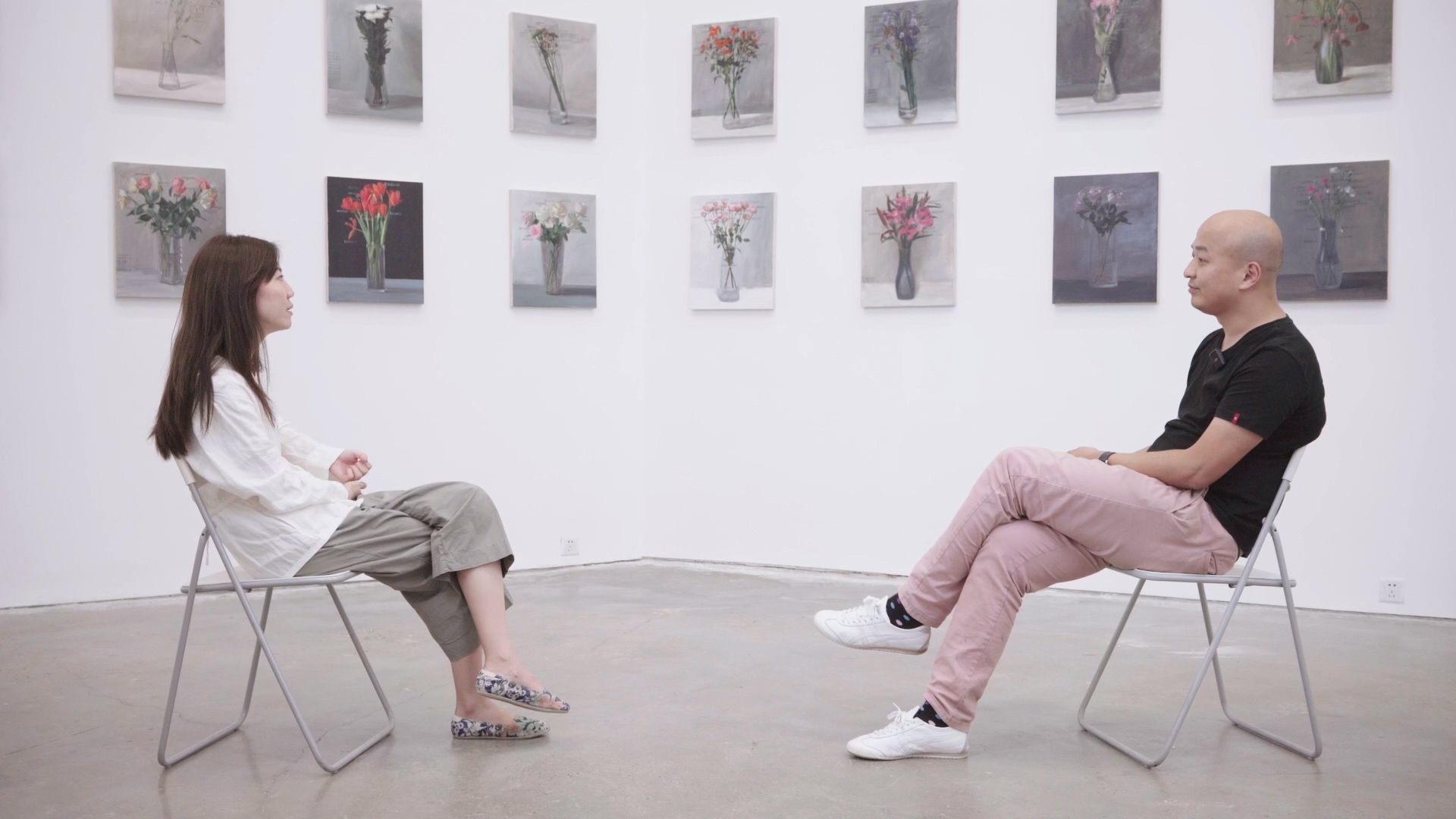薛若哲 李佳
Xue Ruozhe & Li Jia
2023年6月3日
3 June, 2023
李佳:我们从展览的标题开始聊起吧,YYYY-MM-DD其实也是你这次展出的作品系列题目,能告诉我们为什么要用这一串看上去有点特殊的字符当作展览题目吗?
薛若哲:YYYY-MM-DD是我们在申请旅行证件填表时的日期示例,不同国家日期编码中的年、月、日位置都不一样——欧洲国家的顺序和我们就正好相反。通过系列题目展示出来跟旅游、旅游产业的关系。事实上这组作品也是在不断的迁徙中携带完成的。
Li Jia: Let’s start with the title of the exhibition. YYYY-MM-DD is the title of the series of works you are exhibiting this time; can you tell us why you used this odd string of characters as the title of the exhibition?
Xue Ruozhe: YYYY-MM-DD is an example of the date format we use when filling out travel documents. The positions of the year, month, and day vary from country to country – European countries use an order opposite to China. The relationship between tourism and the tourism industry is suggested through the title YYYY-MM-DD. This group of work is also finished during a period when I constantly moved from city to city.
李佳:这组作品应该算是到现在才首次展出,可以和我们介绍一下它的由来吗?以及这些画面背后是什么样的概念驱动呢?
薛若哲:开始这个系列的动因是大女儿出生以来对时间的感受发生了变化,希望通过这样一个行为去锚定流动的时间。这次呈现的这30张并不是一个完结的系列,而是一个在不断地发展中的系列中的第一批画。这一批画开始于左上角那一张,在2022年1月末小女儿出生的时候,我画下了第一朵花。整个项目由她出生开始,每天一朵,持续到我个人生命的终结。每天画完一朵花之后,再标注下当天的日期,比如20220120,相当于填进去了题目YYYY-MM-DD的格式。
Li Jia: This is the first time that this series has been exhibited until now, can you tell us a little bit about its origin? And what is the concept behind these paintings?
Xue Ruozhe: The impetus for this series was the change in my perception of time since the birth of my eldest daughter, and the desire to anchor the flow of time through a specific action. The 30 paintings presented here are not a completed series, but the first paintings in a series that is constantly evolving. This group of paintings begins with the one in the top left corner, where I painted the first flower at the birth of my youngest daughter in late January 2022. The whole project began with her birth: I decided to paint one flower every day until the end of my life, and I mark down the date once I finish a flower. For example, 20220120 is a date in the format of the title YYYY-MM-DD.
李佳:其实我自己的感受,很大程度上也和你说的这种生命的周而复始,这种时间的痕迹相关。所以在一开始设计展览概念的时候,也想到可以去把时间的流逝、运动和轮回在空间中直接表现出来。最后在墙上我们把这30张画分三行排开,也有点像一页月历,日期整齐地排开,每一个日子都是一张画,同时也是一个时间的窗口,这一面墙也成为了一个压缩时间的平面。
也是考虑到这一点,在展览开幕后每一天我们会依次从墙上取下一张画,放在展厅中央的画架上。一方面是为了让观众能以一种日常的距离,更近切,更自然地去看一幅画;另一方面,也是还原若哲写生的一个状态,包括距离,光线,感觉,更重要的是,画取下后墙面上会留下一个空隙,更清楚的标示出时间的痕迹。如果把每一天墙面的样子连起来,会看到这个空档每天依次在移动,就像打在墙上的一束光在一天中移动的轨迹一样。用这种方式再去印证那个时间流逝的过程。
最后,在展厅的另一边,你用video也再一次演示了画面、对象和时间的关系。用一个实时的摄像头,把桌上的一瓶花的影像反映在监视器的屏幕上,你用马克笔在屏幕上画出花的轮廓,随着时间流逝,观众会看到这瓶花的枯萎如何通过监视器上一个所谓的“幽灵影像”,逐渐显示出它和被勾画而固定的那个轮廓,那个时间的切片之间的差距。所以其实整个展览包括的不仅仅是这一批绘画作品,而是要呈现你在这个项目中那些细腻、丰富和多层次的对于时间的思考与刻画时间的尝试,只不过作为一个画家,你还是选择了画布作为这个捕捉时间的动作最终现形的平面。
咱们聊聊墙面上的这批画。这30张作品是按照时间顺序来进行的对吧,是从哪一张开始的呢?
薛若哲:左上角是第一张,按照从左到右的顺序,总共三排,共30张
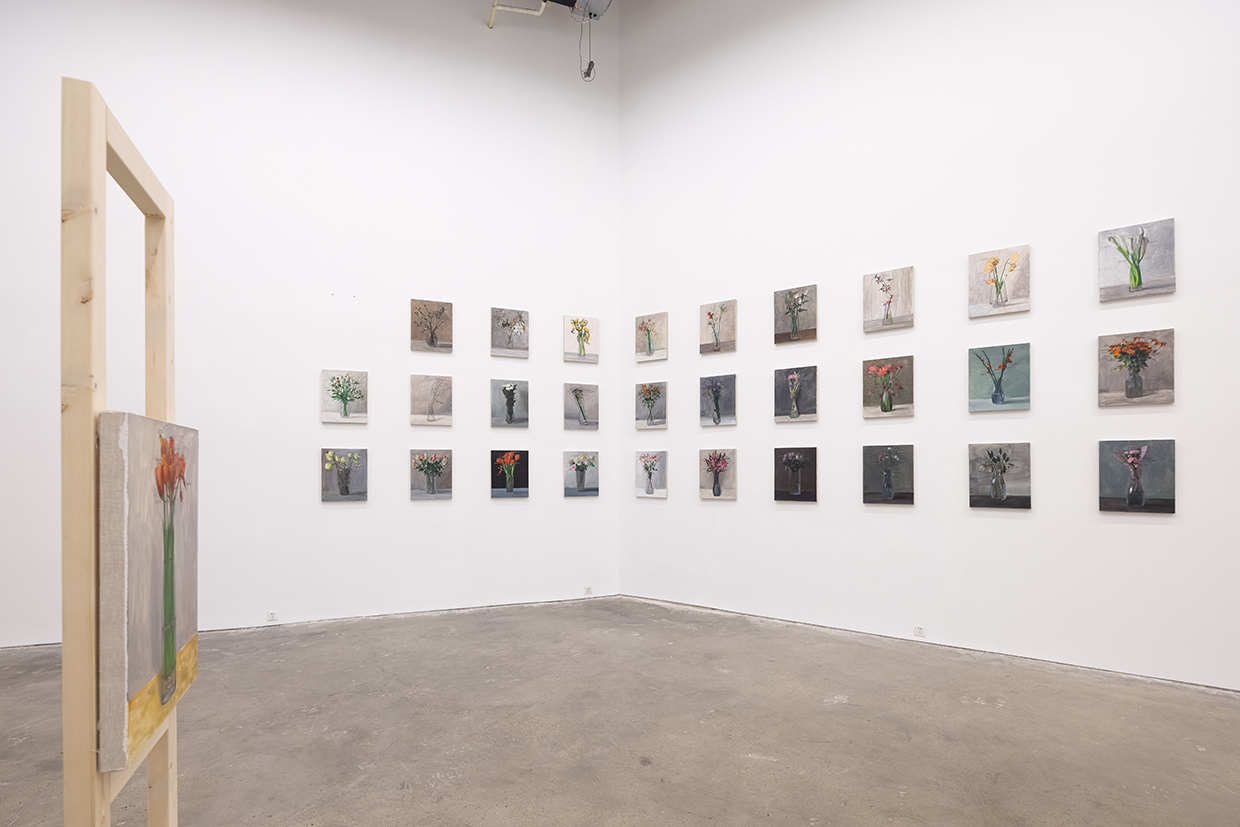
Install view of YYYY-MM-DD at A Thousand Plateaus Art Space
Li Jia: In fact, my feelings are to a large extent similar to what you said about the cycle of life and the traces of time. So when I first thought of the concept of the exhibition, I also thought that we could represent the passage, movement, and reincarnation of time within the space. In the end, we arranged these 30 paintings in three rows on the wall, which is also a bit like a calendar, with the dates neatly arranged; each painting is a unit of time, and this wall becomes a plane that compresses time.
With this in mind, we will take one painting off the wall and place it on an easel in the center of the gallery each day after the opening of the exhibition. On the one hand, this allows the viewer to see a painting more closely and naturally and at an ordinary distance; and on the other hand, it restores Ruozhe’s working state, including distance, light, and feeling; and more importantly, it leaves a gap on the wall after the painting is removed, marking time more visibly. If one were to look at the wall each day, one would see this gap moving daily in sequence, like the trajectory of a beam of sunlight that moves on the wall with each hour. In this way, it is possible to show the passage of time.
Finally, on the other side of the gallery, you demonstrate the relationship between image, object, and time once again using video. With a live camera, the image of a bottle of flowers on the table is reflected on the screen of a monitor, where you outline the flower with a marker. Over time, the viewer will see how the withered vase of flowers, through a so-called “ghost image” on the monitor, gradually reveals the gap between it and the outline, the slice of time that has been drawn and fixed. So it is not just the paintings that are included in the exhibition, but the subtle, rich, and multi-layered reflections on time and the attempts to portray it in this project. As a painter, you have chosen the canvas as the plane on which this capturing of time finally takes shape.
Let’s talk about these paintings on the wall. The 30 pieces are hung in chronological order, which one did you start with?
Xue Ruozhe: They start from the upper left corner and are arranged in chronological order from left to right with three rows, 30 paintings in total.
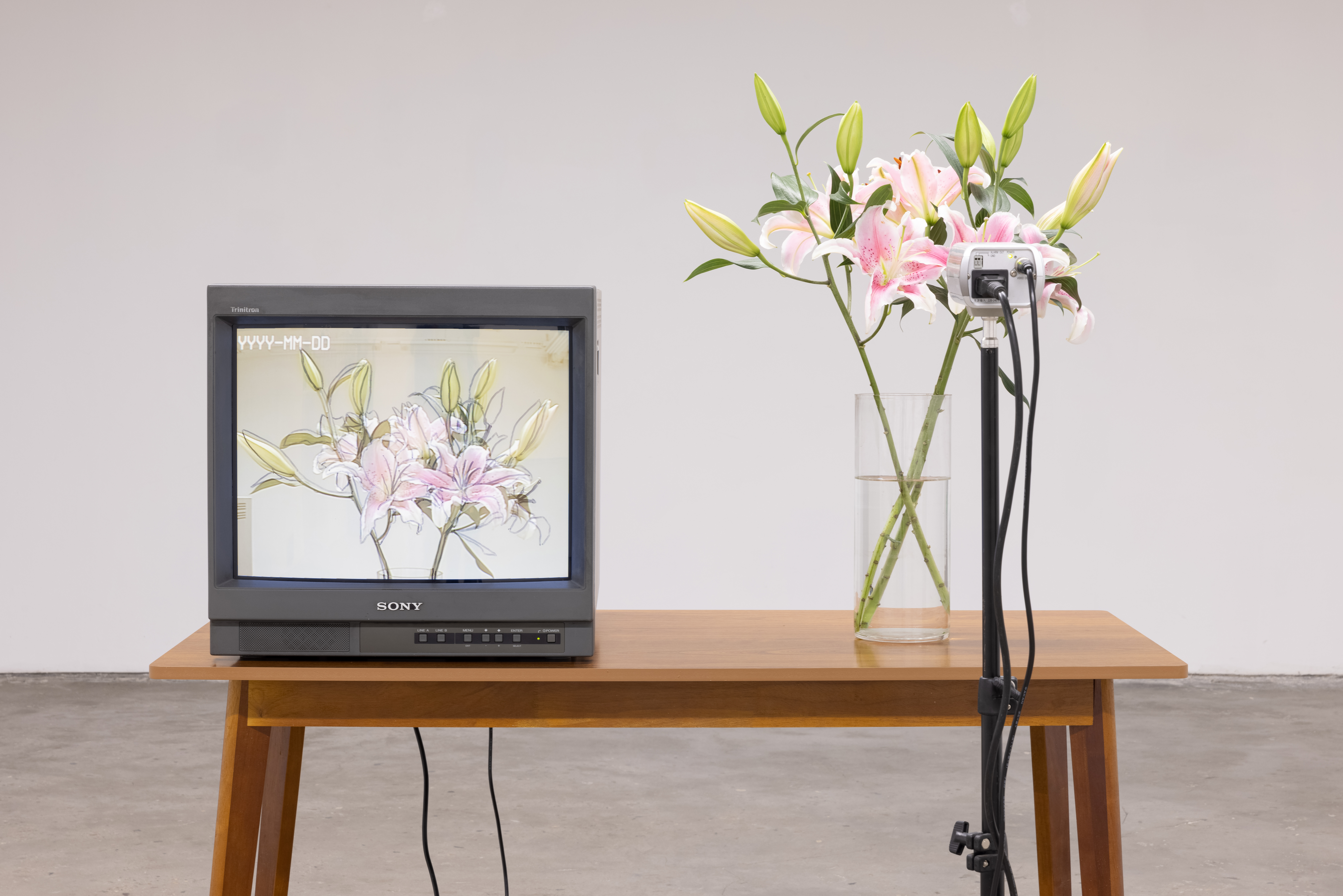
Still Life, installation, 2023
李佳:在这一年半之间,每一天的日期都在这些画面上留下了记录吗? 第一个日期是什么时候?
薛若哲:每一天都在上面。画下第一朵花是在我小女儿出生的那一天——去年的1月20日。 右下角那张就是我展览前的最后一张,其实还有一张正在进行,正在宾馆里写日期,但是没有办法展出。
Li Jia: In the year and a half during which you completed these works, did each date leave a record on these paintings? When was the first date?
Xue Ruozhe: Every day is marked on them. The first flower I painted was on the day my little girl was born – 20th January last year. The one in the lower left corner is the last one before my exhibition. There is another one in progress right now but I am writing the date in the hotel and therefore can’t put it in the show.
李佳:好巧,这一年半的时间最后变成了墙上的30张画,正好是日历上一个月的时间。那按你说的,一天写生一朵花的节奏,完成一张画差不多需要几天呢?可以认为这个创作的周期就是花的枯荣周期吗?
薛若哲:画上这些花束,少的有五六只,多的可能有二十多只,对应着的是在几天到二十多天的绘画时间,它包含了一束花从花苞状态到盛放再到枯萎的完整过程。
Li Jia: What a coincidence that a year and a half ended up as 30 paintings on the wall, which is exactly one month on the calendar. So, according to your rhythm of painting one flower a day, how many days does it take to complete a painting? Can one assume that this cycle of painting is akin to the blossoming cycle of the flowers?
Xue Ruozhe: The bouquets are painted with as few as five or six flowers and as many as twenty, which corresponds to the painting time between a few days and twenty days, and it normally encompasses the complete life-cycle of a bouquet from bud state to bloom to wilting.
李佳:可以相对详细的介绍一下这个创作的过程吗?比如什么时候开始准备花,以及为什么选这束花,每天什么时候画,怎么画,画到什么程度你觉得可以结束了,等等。
薛若哲:在开始画一束花的时候,像所有的写生一样,把这束花大概的位置、颜色在画面上记录下来。在第一天画完这些步骤之后,我会选择一朵花进行深入的刻画,第二天选择另外一朵花刻画。比如这束花有10朵,画到最后一朵的时候,整束花其实已经凋谢了。 第十朵已经处于一个很垂败的状态,我把那种垂败的状态画下来,同时在枯萎花朵的下面,画面的第一层又保留着花一开始插入瓶中时花苞的状态。它是两种时间的并置,所以这张画并不仅仅是描绘某个特定时间,它是十天中流动时间的集合。
花的选择很多样。有些是我在花卉市场买的。我选择花的原则之一,就是不选奇花异草,而是会选择当地会有的花,最好是应季的,所以它也是跟地域跟季节有关的项目;一般以整束为一个单位去选。也有些花,比如说左上角的第二张,是我回家的时候,在望京路边的树上剪下来的。当我画了几天之后,发现它们没有开,一直保持在一个花苞的状态——在花苞的时候就枯萎了。我也把它的状态如实记录下来。
Li Jia: Can you tell us more about your painting process? For example, when did you start preparing the flowers, and why did you choose this bouquet? When and how did you paint it each day? At which point did you feel you could finish it and so on?
Xue Ruozhe: When I start to paint a bunch of flowers, I mark the approximate position and colour of the flowers on the canvas. After these initial steps, I choose one flower to paint in detail on the first day, then on the second day, I paint another. So if there are 10 flowers in the bunch, the whole bunch has withered by the time the last one is painted. The last flower in the bunch to be painted is already very droopy and I paint it in that state. Underneath the wilted flower, the first layer of the painting preserves the initial, vivacious state of the flowers. It is a juxtaposition of two times, so the painting is not just a depiction of a particular time, it is a collection of ten days of fluid time.
There are many options for flowers. Some of them are bought at local flower markets. One of my principles in choosing flowers is that I don’t choose exotic flowers; instead, I will choose flowers that will be available locally, preferably in season and usually sold in bunches as a unit. So YYYY-MM-DD is also a project related to region and season; there are also some flowers, such as the second one in the top left corner, which I cut out from a tree in Wangjing when I was on my way back home. A few days after I had started painting, I found that they did not bloom and had remained in a bud state – wilting while in the bud. I painted it as it was.
李佳:从画面上看,也能感觉到这批绘画和你之前的作品相比有不一样的地方。比如你会在画完的花旁边标注时间,这个记录和打卡的感觉,也会让我联想起谢德庆的行为,或者河原温的日期绘画。
薛若哲:写生有其特殊性,写生时需要有固定的光线和视角,和一个写生对象。我们必须将肉身限制在画架前。
我在画这束花的时候中间会出差,没有办法在静物前写生,但是我又需要每天在画面上Mark一下我的时间,所以我就会把这张花装到我的旅行箱里面。
在旅行的时候每天记下来没有画花的时间,或者说我离开这束花的时间。我把日期写在画面的左下角,从下到上慢慢累积。这些画我都统一设置在了50×40cm的大小,因为这个尺寸是刚刚好可以放到旅行箱里比较舒服的尺寸,这样我在不断迁徙的过程中还能保持跟画的关系。
Li Jia: Looking at these paintings, I can also feel the differences between them and your previous works. For example, you mark the date next to the finished flower. This feeling of recording and clocking in also reminds me of Xie Deqing’s performance, or the date paintings of On Kawara.
Xue Ruozhe: Painting from life has its peculiarities – it requires a fixed light and perspective, and of course an object. We have to confine our physical bodies to the easel.
I would travel during the painting process and I wasn’t able to paint in front of the flowers, but I still needed to mark my time on the canvas each day, so I would pack the painting inside my suitcase.
While I travel, I note down the date I did not paint the flower or the time I threw away the bouquet. I write the date in the bottom left corner of the picture, one by one from the bottom to the top. I set these paintings at a uniform size of 50 x 40cm, as this is just the right size to fit comfortably in a suitcase so that I can maintain a relationship with the painting while I constantly move around.
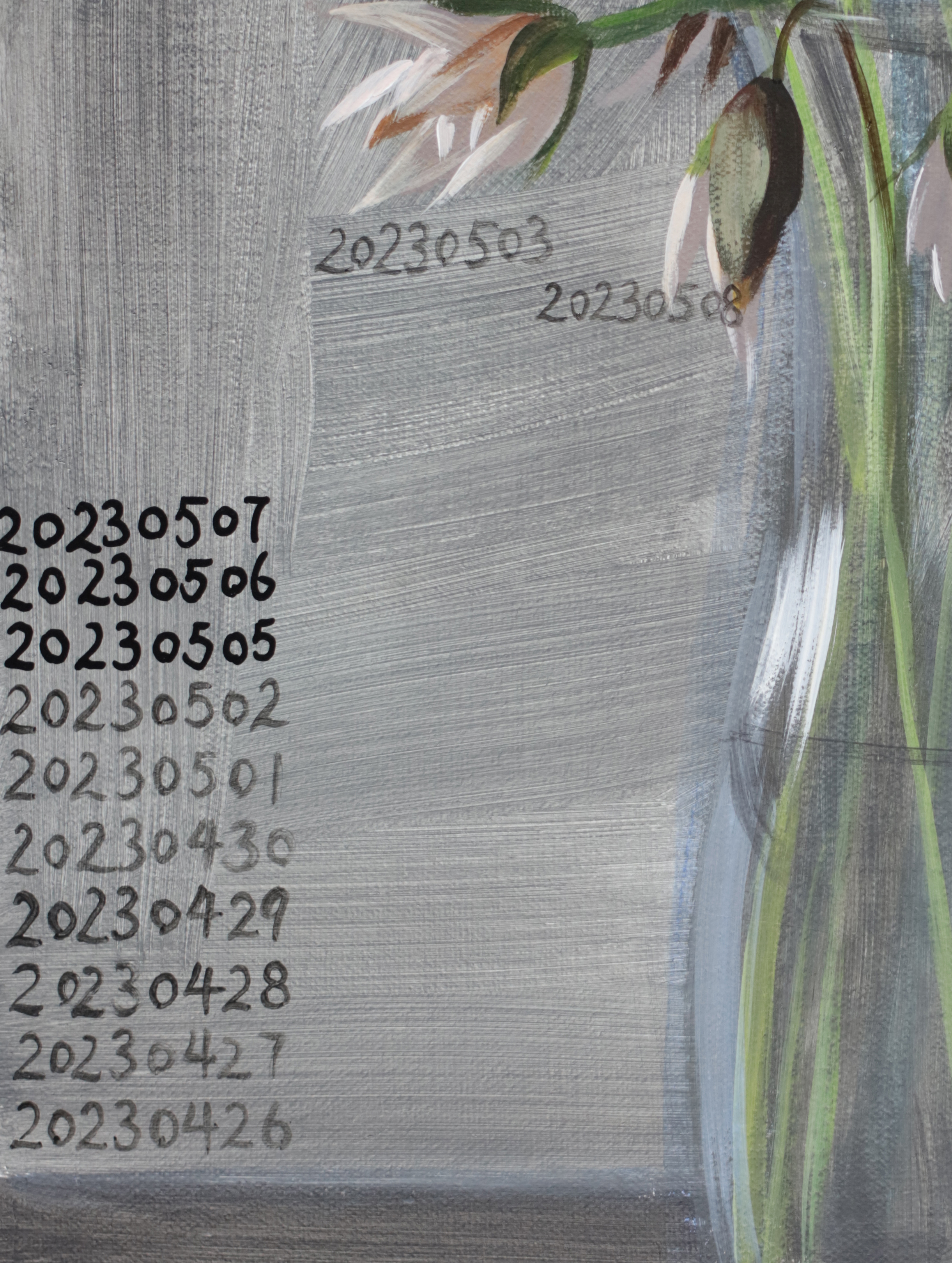
20230425-20230513(Detail), 2023. Acrylic on linen, 50×40cm
李佳:所以这个系列也有点像私人的日记本,你可以随身携带它,每天都在上面标注和记录,日记的内容可能会有不同,或长或短,但是时间已经发生了,不管是有记录或者空白,都以某种方式留下了那一天的痕迹。如果我们把这个系列比做你的日记, 画面上标注的所有日期加起来是不是正好能覆盖你这一年半来的每一天呢?
薛若哲:每一天都没有落下。 当我那一天有特别充分的时间,会花大概一个小时或两个小时的时间专门画一朵花;但如果只有10分钟的时间写生,就会比较概括地去画,几笔把这朵花的形状给抓下来。这跟我的状态也是时刻相关的。我并不会去主动去掩饰,或者为了把花画好去掩饰自己人生中的不确定性,但是唯一确定的是我会在某一个时刻在画面中烙下时间的痕迹,这个痕迹就像是在我生命中每天的特定时刻扎下来的大头针,在流动的时间河流中的一个个锚定的点。
Li Jia: So this series is also a bit like a personal diary: you can carry it around with you, marking and documenting it every day. The content of the diary may be different, long or short, but the time has passed: whether it is recorded or blank, it has left a trace of that day in some way. If we were to compare this series to your diary, wouldn’t all the dates marked on the canvas add up to cover every day of your year and a half?
Xue Ruozhe: I didn’t leave any day behind. When I have a free day, I will spend about an hour or two hours painting a specific flower; but if I only have 10 minutes, I will paint in a more simple and schematic way, capturing the shape of the flower in a few strokes. This creates a temporal relationship with me. I don’t actively try to cover up the uncertainty in my life to paint the flowers well, but the only certainty is that I will at some point leave the imprint of time on my painting – a trace that is pinned down at a specific moment in my life every day, an anchoring point in the river of time.
李佳:没错。也让我想到所谓打卡的行为,其实也是和整个现代的时间制度相关。如果回溯到钟表发明以前,其实人是不太习惯直接从一个均匀的、机械的刻度系统去辨识时间的。时间的结构也相应更像是一个混沌的,光影变化的节律,而不是理性的、刻板的、平均的数值度量。所以有了钟表以后,其实也改变了现代人的时间观念。而这个项目里面特别逗的一点是,这里面数字标注的形式恰恰又是一个数码的,或者说当人们沉浸于各种数字界面之后的一个时间可视化的范例。Yyyy-mm-dd这一串数字,不管你写email还是在word文档里打字,最后结束的时候总会自动蹦出来一串这样的提示,那这个时间格式也是今天我们去认知和计量时间的一个最主流模式。
所以,当你在花卉写生这么古老的一个媒介或者方法里面加上了今天的这样一个数码化的时间格式,我感觉整个画面好像也发生了一些变化,从一个纯粹的形象平面变成了一个数字界面,或者说是形象平面同数字界面的临界点。在这样一个界面里面也有不同的时间体制,不同的时间线索在融汇,一种是我们现代人对于时间的理解:可视的、可切分的、可度量和均匀的;另一种则是我们在成为机械时间的奴隶以前,通过绘画,通过修辞或者其他想像性的手段,以肉身去感知和接纳时间流逝的方式。这个今天已经成为另类的时间体系,好像也被这批作品召唤还魂了。
薛若哲:大女儿出生之后,我突然对时间的流动感觉发生了变化。在生孩子之前,我觉得就是这样一天天过去,不会觉得特别快。当眼看着一个小孩从一点点突然长到很高,我感知到的时间和以前不再一样了。在疫情之中,我们有时候被封控在家,有时候又可以自由流动,这个时候我们对时间的感知也是在时快时慢中切换。所以我试图建立某一种关系,去把这种流动的时间感受给相对的制度化。
Li Jia: Exactly. It also makes me think that the so-called act of clocking in is related to the whole modern time system. If we go back to the era before the invention of clocks, people were not used to read time directly from a uniform, mechanical scale system. The structure of time was therefore more akin to a chaotic, shifting rhythm of light and shadow, rather than to a rational, rigid, steadfast numerical measure. So clocks and watches have changed the concept of time for the modern man/woman. What is particularly amusing about this project is that the digital format of the numbers shows how people who are immersed in various digital interfaces visualize time: YYYY-MM-DD, whether you are writing an email or typing a word document, will automatically pop up at the end of the text. This format is one of the most dominant modes of perceiving and measuring time today.
So when you apply today’s digital time format to such an old medium or topic as flower painting, I feel the whole picture has changed from a pure visual plane to a digital interface, or rather how a threshold has been created between them. In such an interface there are also different time modes, and different time threads merging: one is our modern understanding of time – visible, divisible, measurable, and homogeneous -, the other is the way we perceived and accepted the passage of time physically through painting, rhetoric or other imaginative means before we became slaves to mechanical time. This system of time, which has become the alternative today, seems to have been summoned back to life by this body of work.
Xue Ruozhe: After the birth of my eldest daughter, my sense of the flow of time suddenly changed. Before she was born, I felt like it was just lapsing day by day and it didn’t feel particularly fast. When I witness a child suddenly grow big, the time I perceive is no longer the same as before. Amid the epidemic, our perception of time is also switching between fast and slow when we are sometimes locked down at home and sometimes free to move. So I tried to establish some kind of system to institutionalize this fluid sense of time.
李佳:是的。其实我感觉你之前的绘画里面就已经有了对于时间性的讨论,但可能没有这么明晰。这次因为是30张作品同时并置,所以观众可以非常清晰的看到时间如何紧密又清晰地压缩在一起。但在之前的作品中,可能要从一些非常微妙的地方来感觉时间的流动。比如同一个人,或者同一个对象,它姿态位置在重复中的微妙改变……
薛若哲:非常准确,时间感是我的绘画中的一个重要的元素。 我的作品中经常会出现两个人并置的状态或两个到三个人之间的关系,对我来讲,她/他们并不是一个镜像或者一个双胞胎的关系——当然这个解释是开放的了——我更倾向于认为她/他们是同一个人,她/他是在两个不同的时间截面中出现的,只是把她/他们放在了同一个空间里面,有点类似于两帧相邻的电影胶片之间的关系,它们很类似,它们又不一样。处在不同的时间中,但同时我们看到了这两帧胶片。
Li Jia: Yes. you have already discussed time in your previous paintings, but perhaps not so explicitly. This time, because 30 works are juxtaposed at the same time, the viewer can see very clearly how time is tightly compressed together. In your previous works, we might feel the flowing of time from very subtle details, such as how the postures and positions of the same person change subtly in repetition…
Xue Ruozhe: Absolutely, the sense of time is an important element in my paintings. In my work there is often a juxtaposition of two people or a relationship between two or three people. For me they are not a mirrored image or a twin relationship – although of course, this interpretation is possible – I prefer to think of them as the same person, she/he appears in two different times, I place them in the same space. In a somewhat similar way to two adjacent frames of a film strip, they are alike and not the same at different times, but we see these two frames in one go.
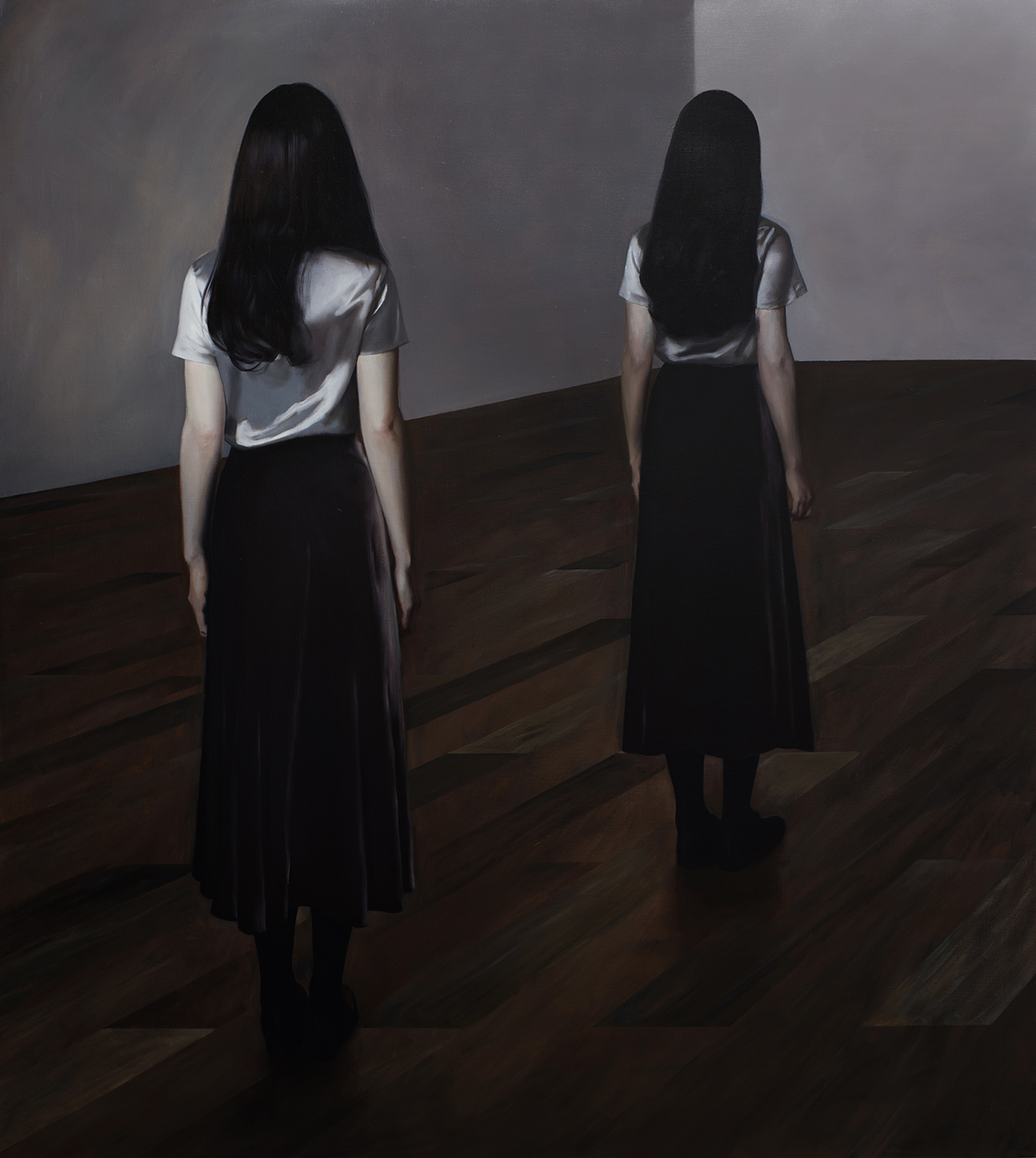
Gymnastics体操, 2017, Oil on linen, 200x180cm
李佳:是的,特别有意思的是你提到两张胶片的叠加,让我想到其实在我们的日常生活中,比如玩电脑游戏或者处理图片,大多都是在一个界面的基础上叠加不同的涂层。像你在早期创作的和虚拟人生相关的系列,也是刻意地让“自然”的画面上呈现出经过编辑的,图层之间的种种关系,用绘画这么一个古老的媒介去模拟和暗示一个当代的界面景观。在你后来的作品中,处理手法变化了,没有那么直接了,但是这里面呈现的,一个对象在重复或者映照折叠之中微妙的变化,其实也会让人想到图层的处理和叠加,只不过没有像这批作品一样非常明确地表示出来。所以,在你的作品中还是有意地渗透了当代人的媒介感觉,渗透了我们已经习以为常的媒介经验,只不过是让我们观看事物的这个出发点不再透明,而凸显出自身。那在这么一个古典的、传统的图像时空中,在一个新古典主义的感觉和气氛塑造的画面中,这些完美和几乎没有破绽的图像通过重复、通过对照,通过微妙的变化,暗示了这个错觉世界中可能的裂痕和破绽,但这需要观众去发现,去追问。
薛若哲:是,需要观众去多一些时间去看关注画面,思考画面。 也需要观众有一些关于绘画的知识,包括对绘画材料特性的理解,还有绘画作为图像的历史的知识。之前王玉冬说我的画面有很多图像上的智力,需要有一些智慧,也需要观众的参与才能共同完成作品。
图层的叠加,是绘画里先天携带的元素:我们在制作过程中,始终需要一遍一遍地去完成。这组画不仅有图层的叠加,还有不同时间层次的叠加:每一张画都有十几个乃至几十个时间层次压在一起,形成了一个共时性的绘画平面——观众一眼就能看透看完整个画面。不像看电影这个线性媒介时,投影的画面是裹挟着我们不断往下发展的,作为观众,永远会期待下一个画面。我希望线性的时间和共时性的画面发生关系,把线性的时间压到绘画平面中去:线性的绘画行为在画面完成时终止,而对绘画的观看行为由目光触及画面时展开。这需要不同色层的叠加,恰当地展现底色层的同时保留覆盖层的丰富性。不仅仅是画面上的丰富,也有时间上的丰富。
Li Jia: Yes, it’s particularly interesting that you mentioned the juxtaposition of two film frames, which reminds me that in our daily lives, for example when we play computer games or work with pictures, we superimpose different layers on top of each other. In your early series related to the SIMS, you also deliberately made the “natural” painting look edited, with various relationships between layers, using an old medium like painting to simulate and suggest the contemporary spectacle of a computer program.
In your works, the way you express yourself has changed, it has become less direct, but the subtle changes in the way a figure is repeated, mirrored, or folded are also reminiscent of the manipulation and superimposition of layers, but not as explicitly as in this body of work.
So, in your work, there is still a deliberate infiltration of a sensibility to contemporary media, of the experience of media that we have become accustomed to, though the starting point from which we observe things is no longer transparent, but serves in fact to reflect ourselves. Then in such a classical pictorial space and time, in an image shaped by a neo-classical feeling and atmosphere, these perfect and almost unbroken images suggest, through repetition, contrast, and subtle variations, possible cracks and breaks in this world of illusion, but it is up to the viewer to discover this and ask questions.
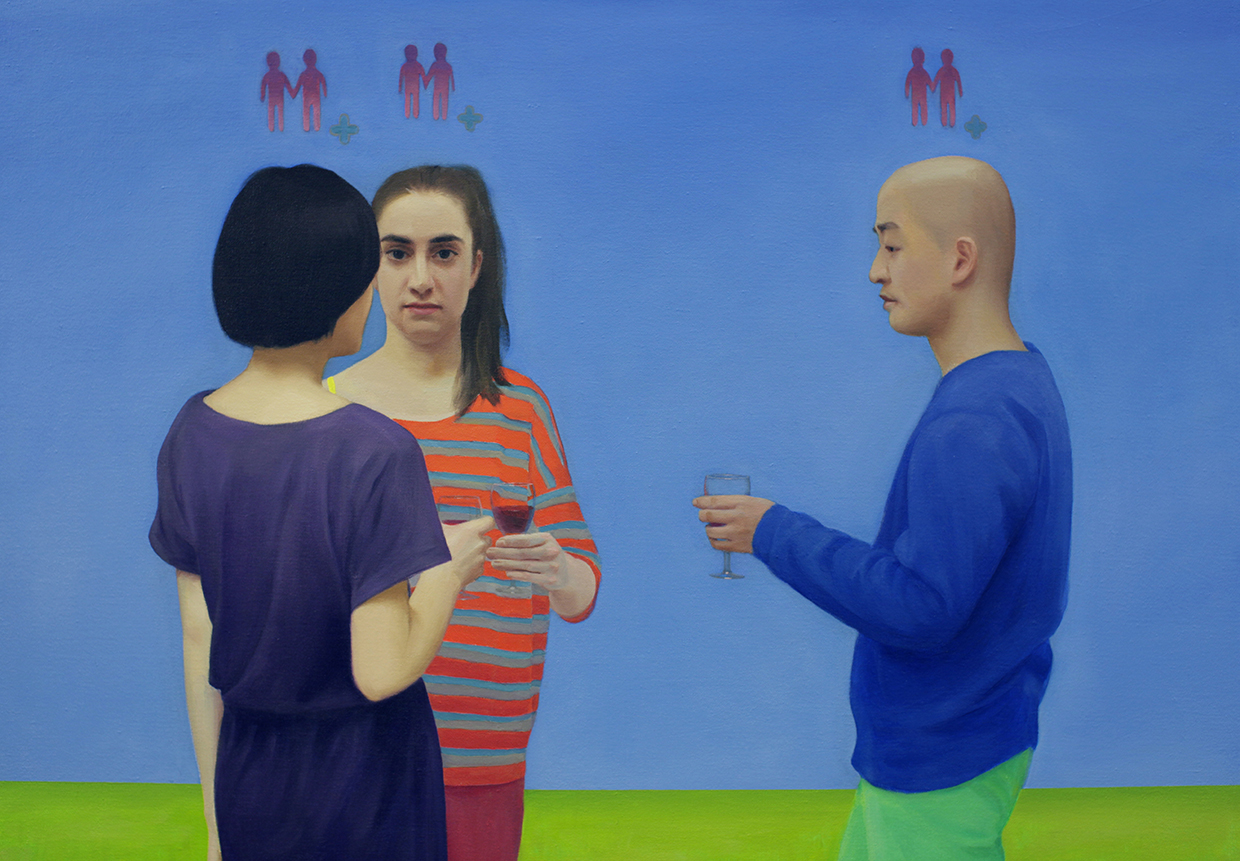
Friendship is Growing友谊在增长(局部) 48×38 in. oil on canvas, 2014
Xue Ruozhe: Yes, it requires the viewer to spend more time looking at the painting and thinking about it. It also requires the viewer to have some knowledge of painting, including an understanding of the materiality of the painting medium, as well as of the history of painting as an image. Wang Yudong said earlier that my paintings have a lot of pictorial intelligence, which requires wisdom and the participation of the audience to be fully completed.
The superimposition of layers is an element that is inherently carried in the medium: we always need to go through it again and again during the production process.
The group of paintings is not only a superimposition of painting layers, but also a compilation of different time levels: each painting has a dozen or more time layers pressed together to form a synchronic plane – the viewer can see through the whole picture at a glance unlike when watching a film, a linear medium, where the projected image is wrapped around us in a constant forward spiral where the viewer is always looking forward to the next image. I want to link the linear time to the synchronic painting surface, pressing time layers into the painting plane: the linear act of painting ends when the picture is finished, and the act of viewing the painting unfolds when the eye touches the picture. This requires the superimposition of different colour layers, revealing the underlying layers while retaining the richness of the overlay. Not only is there a pictorial richness, but also a richness in time.
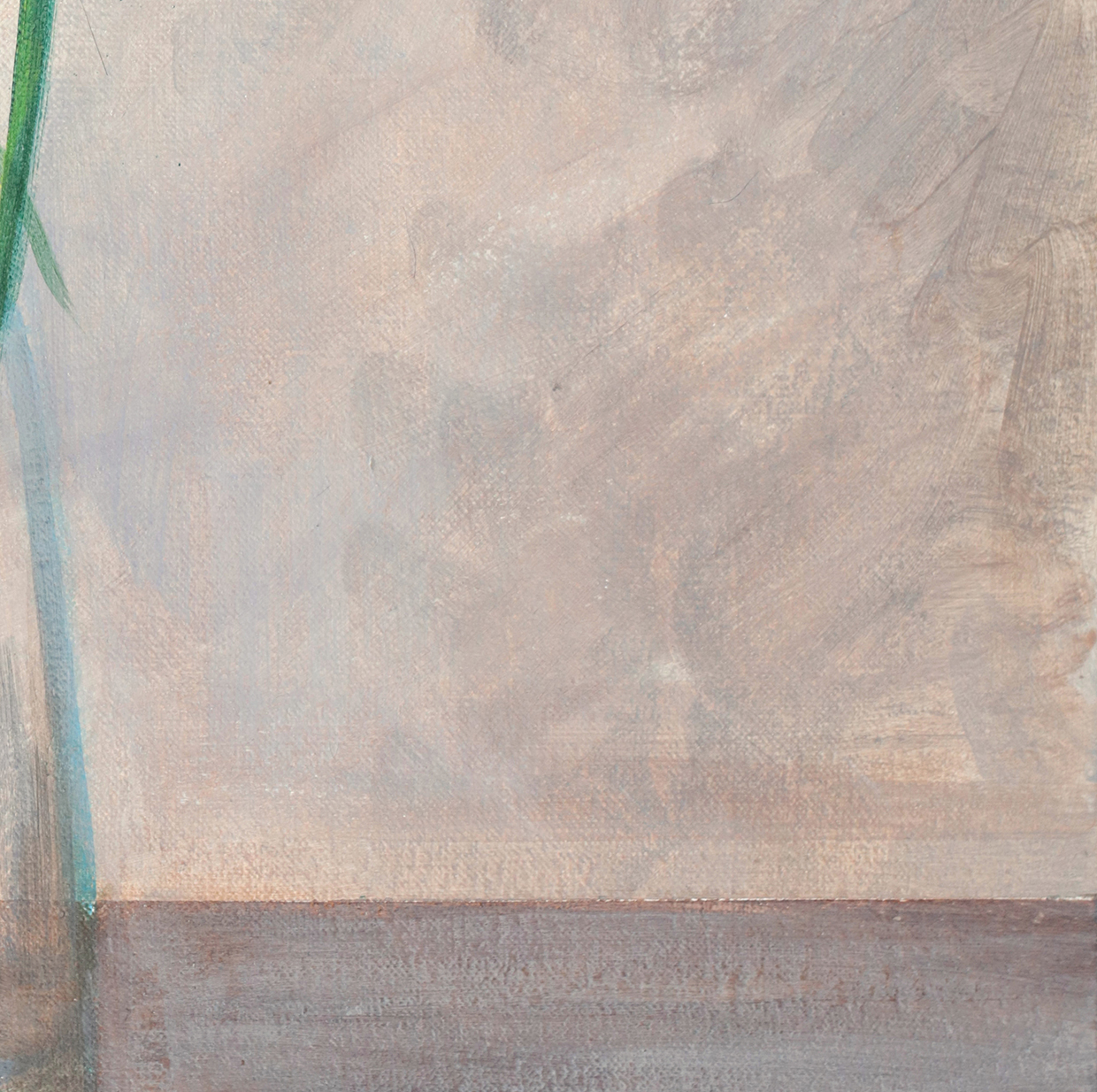
20220328-20220407(detail), 2022. Acrylic on linen, 50×40cm.
李佳:我们看画总会觉得它是一个静止的,既有的存在,因为画框设定的界限,会感觉画的图像平面是从世界里面直接取下的一个切片。但有意思的是,其实每一幅画很可能都是一个漫长的时间过程的产物,只不过当它最终呈现在观众面前,那些在长时段过程中的劳动的痕迹几乎都被删除、覆盖掉了,最终的结果就是眼前这一块图像平面,一个时间的切片。但在你的画面中,通过有意的保留、不加覆盖的叠加、以及人为的标注,让观者意识到时间是如何在画面上累积起来的。这里面有非常直观的方式,比如通过日期的数字标记,来让时间可视化,这也是我们今天去计量和认知时间的典型方式。此外还有不那么直观,但是更久远,更古老的方式,也是跳脱今天的计量理性的视角,去感性把握时间的一种可能。用一朵花来表征和感知时间,在很多文化里都有这样的传统,但其实,一朵花的开或者败,这其中的节律,植物的生命周期是和人类的时间没什么关系的,时间的度量其实是人类的一种发明,或者是人类认识世界的一个视角。当花的枯荣和人的时间叠加,当自然的节律和人类的认知被放在一起来显示其中的重叠和背离,我们会发现在这样一个同时性的画面上其实还隐藏了很多本来不可见的东西。
薛若哲:花跟时间的联系,从古到今都有,比如我们经常说的成语“昙花一现”,就是讲花跟时间。我们也会说:”一花一世界,一叶一菩提。” 由一束花的周期,我们仿佛可以看到一个人的从出生到死亡,乃至一个朝代的兴衰过程,YYYY-MM-DD的每一个单张都是有一个由生到死的过程。它也浓缩了整个系列的一个大的趋势——从我小女儿出生,到我自己肉身的衰亡。但在这个项目中因为时间的连续性的特质,又必须保证它每一张画上的日期都是相连的。
在处理绘画本身的层次时,我不会特别去追求平整,把底下的色层盖掉。一般画第一层的时候,我们会觉得笔触太直接了。但在YYYY-MM-DD中,我刻意保留了一部分底下的色层,透过上面的半透明色层并置起来,也会有一种时间感封存在里面。
当我说绘画材料上的时间感,更多的是指,画面上我们肉眼看到的每一笔都是在不同的时间完成的,但是我们同时看到了它们。
Li Jia: When we look at a painting we always feel that it is a static, pre-existing presence; because of the boundaries set by the frame, it feels like the image plane is a slice taken directly from the world. But the interesting thing is that each painting is probably the product of a long process of time. But when it is finally presented to the viewer, the traces of the labour of the long process have almost all been removed and covered up, and the result is this image plane in front of you – a slice of time. In your picture, through purposeful retention, overlay without covering, and artificial markings, the viewer is made aware of how time has accumulated on the canvas. There are very visual ways of doing this here, such as visualizing time through the dates written, which is the typical way we go about measuring and perceiving time today. There are also less intuitive, but more ancient ways, which can help to grasp time sensually, irrespective of the rational perspective of today’s measurement. The use of a flower to represent and perceive time has been a tradition in many cultures, but the rhythm of a flower’s bloom or fall, the life cycle of the plant, has little to do with human time; the measurement of time is a human invention or a human perspective on the world. When the rhythm of nature and human perception are put together to show their overlap and divergence, we will find that there are many things hidden in such a synchronous painting that would otherwise be invisible.
Xue Ruozhe: The connection between flowers and time has been there from ancient times to the present; for example we often use the cliché “A fleeting blossom”, which refers to flowers and time. We also say: “One flower, one world. one leaf, one Bodhi.” Starting with the cycle of a bouquet, it is as if we could see the process of a person’s life from birth to death or even the rise and fall of a dynasty, and each painting of YYYY-MM-DD has a process that lasts from birth to death. It also incarnates a larger cycle lasting from the birth of my youngest daughter to the demise of my own physical body. In this project, it was again necessary to ensure that the dates on each painting were linked because of the continuity of time.
When dealing with the painted layers, I don’t particularly go for flatness covering off the layers underneath. Usually, we feel that the brushstrokes are too obvious when painting the first layer. But in YYYY-MM-DD, I deliberately kept some underlayers, juxtaposing them with the translucent layers above, which also creates a sense of time.
When I say a sense of time in painting, I mean that each stroke on the picture that we see was done at a different time, yet we see them all at the same time.

20220902-20221007(局部),2022. Acrylic on linen, 40x50cm.
李佳:是的,这好像又和绘画的本体层面的存在有关。一般来说,画家画画的时候,好像是在运用笔触的安排,来实现一种效果,在画面完成的时候,它的意义才显现出来。但之前的种种努力其实都消失在最后的结果当中了。但如果按你的说法,其实每天叠加的时间图层,它本身就成为了目的,而不是为了效果而采用的手段,这些流逝的时间本身也成为了绘画的一个原因。如果我们有一双超出人类之眼,不受这个时空规则限制的眼睛,有一个超越世俗的全能全知的视角,或许看到每一幅画面都是你这些花卉写生这样的,是流逝但并非消失的时间图层的叠加。甚至可以再引申一层,这样一个视角,一个非人类的视角,是否会在未来成为我们的一种经验呢?如果随着技术维度的更新,时间的呈现有了新的方式和媒介,就像电影发明以后,我们已经习惯了一帧一帧的动作分解,习惯了电影所代表的流逝和叙事的节奏,那么未来的绘画很有可能也会随着媒介的更迭,经验的变化而产生新的理解和面貌。
但回到绘画的本体上来说,也许可以把它理解成一个超越最终结果或者完成状态的过程,而这里面的元素、动作、笔触,其实都是在这个图像平面、这个绘画机器中既有一个方向又有独立价值的存在。
薛若哲:没错。 在这里笔触并非要为某种最终效果服务,它本身就在参与画面意义的建立。
Li Jia: Yes, again this seems to be related to the ontological dimension of painting. Generally speaking, when an artist paints, he seems to be using the arrangement of brush strokes to achieve an effect; when this is completed, its meaning becomes apparent. But all the previous efforts disappear from the final result. But if we follow your argument, the layers of time that are superimposed every day become an end in itself rather than a means to an effect, and these passing hours themselves become the painting’s raison d’être. If we had eyes that surpassed human limitations, eyes that are not bound by the rules of space and time, with a transcendent and omniscient perspective, perhaps we would see every image as a layering of time, similar to your floral sketches — time layers that flow but do not disappear. Furthermore, we can extend this perspective, this non-human perspective, to wonder if it will become one of our experiences in the future.
If, there are new ways and mediums for presenting time with the renewal of technology,, just as we have become accustomed to the frame-by-frame deconstruction of motion in films and to the temporal rhythm and narrative that cinema represents since its invention, then it is likely that painting in the future will also take on a new understanding and appearance with the change in medium and experiences.
But in terms of the painting itself, it can be understood as a process that transcends the final state, and the elements, the movements, and the brushstrokes within it are both a direction and an independent value within this image plane, this painting machine.
Xue Ruozhe: That’s right. Here the brushstroke is not meant to serve some final effect, it is itself involved in constructing the meaning of the painting.
李佳:好像绘画一直以来,它呈现出都是一个以人的眼睛为标准,这样一个最终或者完成态的样子。但如果我们今天尝试不把自己的肉身之眼当成一切事物的判断的唯一标准,也许绘画呈现出来的也是一整个世界的记忆。如果我们把身处的世界看作一个巨大无边的、记忆的库存在此刻的共时存在,那么绘画也许也有这样的潜力,能够把记忆晶体的每一个棱面、把时间的每一个层次来呈现出来。就像刚才提到的,电影的发明也是通过技术的手段让人类具有了一种新的去界定时间流逝、界定自我、记忆和时间关系的经验与可能性,那么运用绘画这样古老的媒介,是否也有可能去呈现一种当下的时间经验?比如我们已经习惯于在电脑界面上处理图像、编辑图层,通过剪辑软件让时间倒流等等,这些新的经验和技术也会对绘画这样古老的媒介产生影响。
你曾经提到这一批作品也是你的一个实验,那么最终为什么选择用花来承载呢?以及为什么选这样的一束花?在你概念的设置和思考以外,这里面还有什么个人的,或者是偶然的因素吗?
薛若哲: 花是一种非常好的将时间流逝外化的媒介,花与死亡的联系在早已在古典静物中有体现,英文中关于静物的特定用法——Still Life,就在说生与死之间的状态。我也希望通过YYYY-MM-DD将这个悠久的静物画传统重新与当下、与我个人发生连接。
关于花的选择,也有一些比较个人的因素,我太太是一个特别喜欢花的人,但是她很节俭,自己不太舍得买花。我希望通过一个这样的类似规定或者流程性的东西,保持着每天家里有花,她也会比较开心。这也是我跟她的关系的见证。
Li Jia: It seems that painting has always presented itself as a final or finished state, with the human eye as the standard. But if we try not to take our physical eyes as the only criterion for judging everything today, perhaps painting presents memories of a whole world. If we see the world we inhabit as a vast, boundless repository of memories existing simultaneously at this moment, then painting may also have the potential to present every prism of the memory crystal and every layer of time. Just as mentioned earlier, the invention of cinema was also a means of technology that gave mankind a new experience and the possibility to define the passage of time, the relationship between self, memory, and time, so is it possible to use an “ancient” medium like painting to present a current experience of time? For example, we have become accustomed to manipulating images and editing layers on computer interfaces, rewinding time through editing software, etc. These new experiences and technologies can also have an impact on a traditional medium such as painting.
You mentioned that this series of works was also an experiment for you, so why did you finally choose flowers to carry it? And why did you choose such a bunch of flowers? Was there anything personal or accidental about it, other than your conceptual setting and thinking?
Xue Ruozhe: Flowers are a good medium for externalizing the passage of time. The connection between flowers and death has long been reflected in classical still life paintings, with the term Still Life in English suggesting a state between life and death. Through YYYY-MM-DD I also hope to reconnect this long tradition of still-life painting with the present and with me.
There is also something more personal about the choice of flowers. My wife loves flowers, but she is frugal and doesn’t buy them for herself. I hope that through something like the ritual of having flowers on our table every day she will be pleased, and it is a testimony of our relationship.

Jan van Kessel the Elder
Vanitas Still Life, c. 1665/1670,
oil on copper,20.3 x 15.2 cm (8 x 6 in.)
Gift of Maida and George Abrams,
National Gallery of Art, Washington D.C.
李佳:这个故事也特别的感动我。 其实很多人都会用花来寄托情感,但是花枯萎之后,好像这一段时间就过去了。但这段时间里面蕴含的情感强度,如果能通过这样的方式持续下来,好像就变的更有意义,更浪漫,但这个浪漫不是情调,而是我们作为人类,如何把记忆去变成一个可见、可分享、可以传递的东西。
你也提到这一张画里面其实包含了一个周而复始的过程,一束花插在那,它慢慢就彻底枯萎了,就消失了,这个花的生命周期就走完了,但是绘画的周期开始了;同时人的生命也是这样的周期在无声的运行着,这种循环不息的过程真的很奇妙。
薛若哲:自从女儿出生之后,我感觉到了一种生命在循环的感觉,因为老大长得特别像我,好像是我又生了一遍。就是一个不断地老的消逝,新的生长的循环。每一张画的小小循环也映射着整个生命的过程。 我总觉得YYYY-MM-DD是没有一个那种历史主义的进步观的,它始终是处在一个不断地内部循环的状态,它的时间观其实也不是线性的。
Li Jia: This story also deeply touched me. Many people use flowers to express their emotions, and after the flowers have withered, it seems that a period has passed, but the intensity of the emotion contained in this period seems to become more meaningful and romantic if it can be sustained somehow. Yet this romance is not merely a sentiment, but rather a reflection of how we, as human beings, can turn memories into something visible, shareable and transferable.
You also mentioned that this painting contains a process of repetition: a bouquet is placed there, it slowly withers and disappears, then the life cycle of the flower is finished. But on the other hand, the cycle of painting begins; meanwhile, the life of a human being also runs in such a silent cycle, an endless kind of cycle.
Xue Ruozhe: Since my daughter was born, I feel a sense of the cycle of life, because the eldest daughter looks like me and it is as if I was reliving my own life again. It’s a constant cycle of the fading away of the old and the growth of the new. The little cycle of each painting also maps the whole process of life.
I always feel that YYYY-MM-DD does not have that kind of progressive view of historicism. It’s always in a state of internal circulation. Its view of time is not linear.
李佳:记得你之前曾经提到过,你说自己要用绘画去解决绘画的问题,而不会把它留给观念。其实我在这组作品里面感觉也很明显,虽然这里面有观念的成分,甚至让人想到谢德庆、河原温这样的实践,但更多还是专注于绘画本身的奥秘。其实像莱辛很早就谈到了时间与空间艺术、诗与画的分界等等,但是用绘画这个空间形式来解决时间的表现,其实还是又回到了这个媒介本体的东西上。所以也特别想多听你聊聊,是如何思考这个问题的,以及你在绘画中最关注的是什么。
薛若哲:我所关注的有几个主要问题,包括绘画与空间、绘画与时间,当然还有绘画中的真实的问题等。你有提到我的绘画跟观念的关系,其实我一直特别谨慎的去处理这对关系,因为我认为绘画并不是一个很理想的承载观念的媒介。 做观念作品,很重要的一点就是选择的媒介要准确,但是绘画没有办法做到很准确,因为它始终是一个热的媒介。即使是那种照相写实主义那种冷,也始终有肉身的存在。
但是YYYY-MM-DD恰好落在了绘画与观念的临界点上,它的观念涉及到了绘画的本体层面。在此既不需要抛弃掉绘画材料肉身制作的特质,又提供了时间这个接口切入观念的世界,把绘画过程中出现的元素作为形成观念的要素显现出来。比如说,绘画的层次累加跟绘画的时间性可以叠合,二者具有同构性。
Li Jia: I remember you mentioned before that you wanted to use painting to solve the problem of painting itself, rather than leaving it to concepts. It is obvious to me in this group of works that they, although there are conceptual elements in them reminiscent of practices like Xie Deqing and On Kawara, are more focused on the mystery of painting itself. In fact, G.E. Lessing has long talked about time and space in art, the division between poetry and painting and so on, but using painting as a spatial form to address the representation of time comes back to the essence of the medium. So I would like to hear more about how you think about this issue and what is your major concern in painting.
Xue Ruozhe: There are several issues that I am concerned with, including painting and space, painting and time, and of course, the question of authenticity in painting. You mentioned the relationship between my paintings and concepts. I have been very careful in my dealing with this relationship, because I think painting is not an ideal medium for carrying ideas. To make conceptual works, it is very important to choose the right medium, but painting cannot be very accurate because it is always an emotional medium. Even if it can be almost objective like in photorealism, there is always a corporeal presence. It cannot be completely detached and objective.
However, YYYY-MM-DD falls right on the threshold between painting and conception, and its concept involves the ontological dimension of painting. Here it is not necessary to abandon the qualities of the corporeal nature of painting, but to also provide the interface of time as an intrusion into the world of concepts, revealing the elements that emerge during the painting process as elements that form concepts. For example, the accumulation of painted layers can be aligned with the layering of time in painting, and in this sense they are isomorphic.
李佳:再回到这些画本身,每张画的背景和色调都有差别,这是出于什么样的考虑呢?还是很随机的,比如和当时的天气,心情相关?
薛若哲:放置花瓶的背景基本上都比较单调,最重要的要求是要放在一个可以触手可得的环境——比如家里的一面墙。如果选择在工作室的话,哪天有事不去工作室就没法画了。我会根据自己那天的状态,或者画面契合度去选择背景应该怎样。当我感到安静,笔触就会相对平静一点;有时又会涂得像狂风暴雨一样。
这个项目有意思的地方在于,一方面它有着很强的限定性,有一个不变的规则:花瓶摆在中间,地平线的高度一致,每一朵花旁都要签上当天的日期;但另一方面又很私人、时时在变化。它与我的个人生活,某些具体时刻的状态息息相关。这两种几乎要打架的元素,同时发生在了一个画面里。
Li Jia: Going back to the paintings, the backgrounds and tones vary from painting to painting, what was the reason for this? Or is the mood at the time of painting random like the weather?
Xue Ruozhe: The background for the vases is monotonous, the most importantrequirement being that they be placed in an environment where they can be reached – for example, in front of a wall at home. If I choose to work in the studio one day, I can’t paint if I’m not there. The choice of the background depends on how I am feeling that day, or what the colour scheme is. When I’m feeling quiet, the brushwork is relatively calm; sometimes I paint much more nervously.
The interesting thing about this project is that on the one hand, it is very restrictive in that there is a rule: the vase is in the middle, the horizon is at the same height and each flower is dated next to it, but on the other hand it is very personal and changes from time to time. It is tied to my personal life, to the state of certain moments of my life. These two rather opposite elements, occur simultaneously in one painting.
李佳:如果我们现在看这其中的一幅画,以及上面一个一个日期,你还能还原出当时那一天的感受吗?这批作品是不是对你来说也像类似于记忆索引,或者日记本的意义?
薛若哲:不一定会记起具体的什么事了,但是每张画都能想起来那一段时间是一个什么样的感受:是匆匆忙忙的感觉,还是一个比较稳定在家里的状态。 有几张是我疫情被封控在学校里的时候画的,那时候就心如止水。看到画就能回忆起来当时那种感受。这里面有个人史在其中,也有个人时间和公共时间的关系。
Li Jia: If we look at one of these paintings now and at the dates on it, can you still recall the feeling of that day? Do you see this body of work as a memory index or a diary?
Xue Ruozhe: I don’t necessarily remember anything specific, but in each painting, l can
remember what my feeling was while I painted. A few of them were painted when I was locked down at school during the epidemic. My mind was at a standstill. When I saw the paintings, I could recall how I felt at that time. There is a personal history in these works, as well as a relationship between personal time and public time.
李佳:还有一点我觉得也特别有意思,之前你简单提过一次,就是关于这批作品的画法。这些花都是用丙烯画的,但你大多数作品都是用油画颜料;另外,你曾经介绍过,当颜色调好了之后,其实可以在画布上一次画很多不同的东西,但是像这个花,因为每天重新回来写生,它总会有一些变化,所以每次都要重新调色。在我看来,这个重新调色也特别像重新回到绘画的开始,这是一个属于绘画的周而复始和重新出发。 虽然最后这些天的时间叠加进一张画,但是每天你都要回到那个起点,重新去问自己什么是绘画,重新去从原点来出发 。
薛若哲:其实作为画家来讲,每天都要重新去调一遍颜色,并不是一个特别让人愉悦的经历。正常状态下写生一个静物,大致同样的颜色,调出来之后,都画一遍之后再微调——有些偏冷一点,有些偏暖一点。但当画这组画时,每次都要重新调大致一样的颜色,好像每天的努力都要归零再来。
至于为什么选择丙烯,是因为丙烯这个材料分层很快:不用慢干丙烯的话,几乎立刻就干了,意味着每天画的那朵花都处在不同的色层中。而油画在冬天的干燥时间经常长达一个星期,甚至半个月,没有办法很好地分层,就会干扰到这个系列的概念。
Li Jia: Another point that I find interesting, which you briefly mentioned once before, is about the painting method of this body of work. These flowers are all painted in acrylic, but most of your works are oil paintings; in addition, you said previously that once the colours are mixed, you can paint many different things on the canvas, but because you come back to paint every day when painting YYYY-MM-DD, there are always some changes, so you have to mix the colours again every time. To me, re-colouring is in a way the essence of painting and reenacting it each time is a cycle and an iteration that belongs solely to the painting medium. Although the days are compressed into one painting, you have to go back to that starting point every day, ask yourself what painting is and start again from the beginning.
Xue Ruozhe: As a painter, it is not a particularly pleasant experience to have to mix the colours again every day. Under normal circumstances, I would paint the flowers in similar lighting situations with roughly the same colours, paint it all over again, and then fine-tune it; some are a bit cooler, some are a bit warmer. But when painting this group of paintings, it was as if every day’s effort had to be zeroed in on again by having to re-mix similar colours each time.
As for acrylic, it is because acrylic is a material that settles very quickly: unlike oil painting that is slow to adhere, it dries almost immediately, meaning that each day the flower is in a different colour layer. Whereas oil paintings often take up to a week or even half a month to dry in winter, there is no way to put different flowers in different layers, which would interfere with the concept of this series.
李佳:那你需要每天来定一个精确的时间段来写生吗?
薛若哲:不会特别的精确,但是大致是同一个时间段去画。
我现在比较倾向于早上画,因为早上的时间比较具体,能安排好大概是一个什么样的时间段去画。当然也跟我的生活状态有关:现在在广州我是一个人,可以安排好早上的时间。回到北京后家里有小孩,就要调整到一个相对空闲的时间段。
Li Jia: Do you need to set a precise time everyday to paint?
Xue Ruozhe: It’s not particularly precise, but it’s roughly the same period.
I tend to paint in the morning now because it is more specific and I can arrange a rough time frame to paint. Of course, it also depends on my circumstances: now I am alone in Guangzhou, it is easy to organize my time in the morning. When I return to Beijing and have children at home, I have to find a relatively free period to paint.
李佳:这让我想到激浪派,或者像宋冬这样老一辈的艺术家会把艺术变成生活的一种方式,比如宋冬也有一个水写日记的项目,他每天都会用水来写今天的日记,但是水蒸发后就不会留下任何字迹。这个作品更像是他个人的一种操练,或者说,是艺术家验证我之为我的一种方式。这种实践是很激进的。回到你的这个系列,虽然绘画大家都认为是经典的架上媒介,但是它可能更接近宋冬水写日记这样一种激进的尝试。只不过也许因为你是一个画家,所以采用的方式还是画画,用画画来定义你和艺术之间的根本关系。但这个画画不再是一种职业,不再是一个工作室里面同你的生活分开的过程,而是你用以认知和验证自我,去串联自己的生活,寻找意义的方式。
薛若哲: 这组项目是一个持续一生的项目,它跟我的个人经历、对生活的感受,乃至每天的时间安排都是息息相关的。它并不是另辟时间,专门去画一张/组画的时候那种状态——把所有的东西都弹开,去做某件事。YYYY-MM-DD始终是伴随着我的生命的。
Li Jia: This reminds me of Fluxus and of the older generation of artists like Song Dong who would turn art into a way of life, for example, Song Dong also had a water diary project where he would use water every day to write his diary, but the water would evaporate and leave nothing behind. This work is more like a personal exercise for him, or rather, a way for the artist to validate what he is about. This practice is very radical. Going back to your series, although painting is considered a traditional medium, it is probably closer to Song Dong’s radical attempt to keep a water diary. Perhaps because you are a painter, the approach you take is still painting, using painting to define your fundamental relationship with art. But this painting is no longer a profession, no longer a process separate from your life in a studio, but a way for you to perceive and validate yourself, to connect your life, to find meaning.
Xue Ruozhe: This project is a lifelong project, it is closely related to my personal experiences, my thought about life, and even my daily schedule. It’s not a state when I have to dedicate time to one painting/group of paintings – to bounce everything off and do something. Instead, it is an inherent part of my life — a continuous state.
